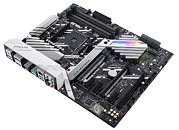Monday, June 3rd 2019

AMD 300-series and 400-series Motherboards to Lack PCIe Gen 4 with Ryzen 3000
This shouldn't really need to be spelled out, but AMD clarified that you can't have PCI-Express gen 4.0 running an upcoming Ryzen 3000 "Matisse" processor on older socket AM4 motherboards based on AMD 300-series and 400-series chipsets, and that the processor's PCIe root-complex will run at PCI-Express gen 3.0 speeds. AMD's official reason for this is that the older motherboards can't guarantee reliable signaling needed for PCI-Express gen 4.0 and hence the company decided to blanket-disable PCIe gen 4.0 for the older platforms. This statement was put out by Robert Hallock, senior technical marketing head for CPUs and APUs, on Reddit.
Unofficially, though, we believe there are technological barriers standing in the way of PCI-Express gen 4.0 on the older motherboards, the least of which are the lack of external PCIe gen 4.0-certified re-driver/equalizer components, and lane-switching on boards that split one x16 PEG link to two x8 links. There may be other less technical issues such as PCI-SIG certification for the older platforms. Intel faced a similar challenge with its 3rd generation Core "Ivy Bridge" processors, which introduced PCI-Express gen 3.0 to the mainstream desktop platform, and were backwards-compatible with Intel 6-series chipset (eg: Z68 Express). The older 6-series motherboards could only put out PCIe gen 2.0 with the newer processors.
Source:
Robert Hallock (Reddit)
Unofficially, though, we believe there are technological barriers standing in the way of PCI-Express gen 4.0 on the older motherboards, the least of which are the lack of external PCIe gen 4.0-certified re-driver/equalizer components, and lane-switching on boards that split one x16 PEG link to two x8 links. There may be other less technical issues such as PCI-SIG certification for the older platforms. Intel faced a similar challenge with its 3rd generation Core "Ivy Bridge" processors, which introduced PCI-Express gen 3.0 to the mainstream desktop platform, and were backwards-compatible with Intel 6-series chipset (eg: Z68 Express). The older 6-series motherboards could only put out PCIe gen 2.0 with the newer processors.

62 Comments on AMD 300-series and 400-series Motherboards to Lack PCIe Gen 4 with Ryzen 3000
motherboards that were overbuilt for 5GT/s but received 8GT/s certification and Gen3 compliancy tested when IB-E came out.
See the thing is, I really expected amd to deliver a 16 cores right now and break the paradigm we have had for 10 years, unfortunately they have not, okay they helped to break some of it but not as somebody that want to lead the industry to new heights. AMD wants to milk in just like intel have done to us in the past 10 years or so, okay amd might launch a 16 cores next year but for now are just rumors and even if they launch intel will have had time to counter it with same core count and amd in the end wont have made an impact like intel did with the i7 920 in 2008. I think the i7 920 was the best cpu purchase of all time to date and for just $284.
Do you know when we see everything is F***ed at intel? is when Intel shows that their i7 is not high end anymore. The i7 at the top lasted almost 10 years and it started with the i7 in November 2008. The creation of an i9 series shows that intel's reign is over but does not not mean amd is the new king of the hill, it shows there is a balance at moment.
en.wikipedia.org/wiki/List_of_Intel_Core_i7_microprocessorsI found this article today 04 june, at anandtech, related to your post.
www.anandtech.com/show/14475/gigabytes-pcie-4-0-ssd-uses-77g-of-copper-due-to-8w-tdp
First of all, chipset does not provide x16 links. That wouldn't even make sense with narrower uplink link.
Second, lanes do not magically multiply, just because certain configurations have equivalent speed.
PCIe 3.0 x16 GPU in a 4.0 x8 slot will work at 3.0 x8.
PCIe 4.0 x2 NVMe drive put into 3.0 x4 slot will work at 3.0 x2.CPU does not have 40 lanes. You're looking at a sum of both cpu's and chipset's lanes.
Check again what puts out what, and the reason why even the high end motherboards come up in "x16 ,8 ,4" setting will be clear ;)